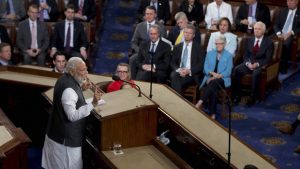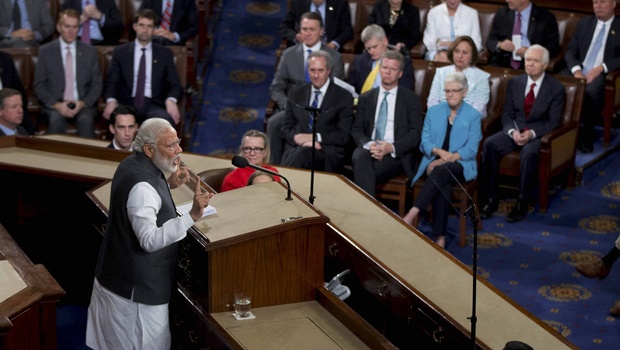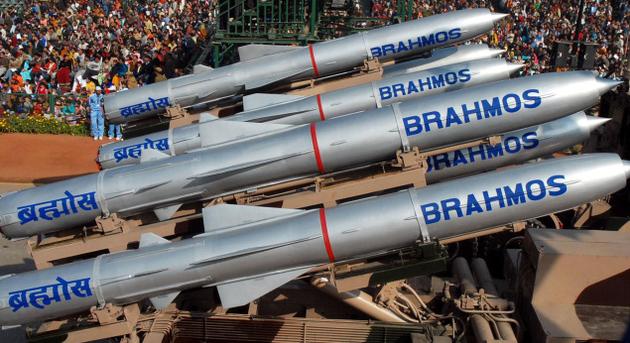S. Gurumurthy
Ten standing ovations! And 69 clapping interventions! Indices of the reception Prime Minister  Narendra Modi got from the Joint Session of US Congress when he addressed them as if extempore for 45 minutes on Wednesday (June 8) during his fourth visit to the US in two years. After his speech, many Congressmen even queued up for his autograph! A definite contrast to 2005, when his predecessor, Dr Manmohan Singh had read out a life-less text to the US Congress in English — a language in which only he was felicitous. But Modi delivered an extempore speech (hardly anyone knew a teleprompter was in front of him) in English — the language in which he is least felicitous. The contrast does not end here. Manmohan Singh then was the toast of the US government which hated Modi the most. Modi pole-vaulted over all hate campaigns and U-turned the US within months after he became Prime Minister. CNN commented that Modi’s speech, which capped “something of a phoenix-like rise for both the man and his country’s relations with the US”, was “interrupted throughout by applause from law makers”. The Wall Street Journal, never greatly friendly to Modi, echoed CNN and said, “Leader wins warm reception from US lawmakers” which “capped a big turnaround for Mr Modi, who once was banned from entering the US” under a law passed by Congress! Modi “even joked about the partisan split of the lawmakers before him” like it happens in India, pointed out CNN. Usually our intellectuals will say, “See how well the US Senate or Congress performs and how bad we are”. He told US law makers: “your Congress compares with our Rajya Sabha!”
Narendra Modi got from the Joint Session of US Congress when he addressed them as if extempore for 45 minutes on Wednesday (June 8) during his fourth visit to the US in two years. After his speech, many Congressmen even queued up for his autograph! A definite contrast to 2005, when his predecessor, Dr Manmohan Singh had read out a life-less text to the US Congress in English — a language in which only he was felicitous. But Modi delivered an extempore speech (hardly anyone knew a teleprompter was in front of him) in English — the language in which he is least felicitous. The contrast does not end here. Manmohan Singh then was the toast of the US government which hated Modi the most. Modi pole-vaulted over all hate campaigns and U-turned the US within months after he became Prime Minister. CNN commented that Modi’s speech, which capped “something of a phoenix-like rise for both the man and his country’s relations with the US”, was “interrupted throughout by applause from law makers”. The Wall Street Journal, never greatly friendly to Modi, echoed CNN and said, “Leader wins warm reception from US lawmakers” which “capped a big turnaround for Mr Modi, who once was banned from entering the US” under a law passed by Congress! Modi “even joked about the partisan split of the lawmakers before him” like it happens in India, pointed out CNN. Usually our intellectuals will say, “See how well the US Senate or Congress performs and how bad we are”. He told US law makers: “your Congress compares with our Rajya Sabha!”
The outstanding US Congress reception to Modi is the latest outcome of Modi’s two-year strenuous effort to influence not just the US but the world — first, to hedge and neutralise the Modi-haters in India and their collaborators in the West, who had tarnished his image and dented the high legitimacy needed for his office, and, next, to legitimise himself and get the world into his efforts to lift the nation’s global stature and economy. The time and effort he put in has undoubtedly met with resounding success. Modi, now among the tallest leaders in the world, has taken the nation close to strategic global regimes in missiles and nuclear domains. India is more than ever nearer the UN Security Council. Its stature and influence today match China’s. It has dwarfed and reduced Pakistan to survive as baggage of China. The intimacy Modi has with US President Barrack Obama, the most unlikely friendship for the latter as The New York Times said, has even puzzled many. He has begun silencing his and India’s critics in US. CNN has reported that, “Modi’s deft performance likely means complaints will be on the back-burner during his visit to Capitol Hill.” Modi’s journey to global stardom, now a high value strategic asset for India, was no accident. It was a well-thought out tactical course scripted by team Modi. After Chanakya, Shivaji and Gandhi, India hardly produced many strategic statesmen. Modi has clearly emerged as the chief strategist for India. See how Modi U-turned the world in his favour.
From untouchable to “rock star world leader”
Demonised for over a decade by Modi-hating seculars and liberals as some Hindu version of Hitler — all assisted by foreign-funded NGOs, anti-India forces and mainstream media — Modi rightly judged that he could not successfully execute the people’s mandate within if he did not have a higher legitimacy than just parliamentary majority. The anti-Modi poison injected in tons into the Indian discourse was exported and marketed abroad through anti-India lobbies in the West and then it was re-imported with multiple effect back to India to tell the Indian people, “see how the West too is ostracising by denying visa to him”. But after getting the stunning mandate Modi faced the hard choice about where to begin redeeming his name — within or abroad. He tactically zeroed in on the West which, he felt, would respect a democratically-elected popular leader more than his haters at home who had a vested interest in keeping the hate campaign going. He also knew that once he made a positive impact abroad, it would be imported into the Indian discourse just as his wrong image outside was imported to harass him. He planned and undertook an unprecedented and punishing schedule of foreign visits — 37 trips involving 98 days — in two years till now. But again tactically he began with the neighbourhood visits before moving to the West. The Wall Street Journal, which first sensed his strategy, wrote on May 13, 2015: “Mr Modi’s packed travel schedule has been one of the most-notable features of his first year as prime minister”, adding that in his first anniversary Modi would have travelled to 18 different countries, spent 52 days of his first 365 outside of India. WSJ said, “Pictures of the prime minister with major world leaders like Barack Obama in the US and Angela Merkel in Germany also create an image back home that Mr Modi is a world player and promoting India as a global power.” After this comment, Modi went abroad 20 more times, including thrice to US!
Strategic approach
Yes, his global strategy was as much a tactic to establish himself and raise India’s stature abroad as it was his extended domestic political strategy to contain the hate campaign against him. He had unveiled his strategy even before he was sworn in. He boldly decided to invite all SAARC leaders to the swearing, risking the refusal of Pakistan Prime Minister Nawas Sharif who he had invited on the understanding that there would be no ‘K-word’, (no mention of Kashmir) in the discussions, no press meet and no meeting with the Kashmir Hurriyat. Had Sharif refused to come or breached the understanding, that would have spoilt the swearing-in party. But risk-taker that he was, he had his way throughout. His demonstrated speed, scale and height in planning his visits by leveraging on his popularity with the expatriate Indians. His rallies abroad in US, Australia or England or in the Middle East were as well-attended as in India or even better like the one in London. They were a new experience for the host nations to witness the popularity of leader from outside among their own residents. Modi needed no seer to tell him that in all democracies popularity of a leader with the people is the real test. Understanding this psychology Modi brilliantly strategised his global thrust.
As Modi expected, media in the West was overawed by the scale of his rallies. Writing on Modi’s Madison Square Garden rally, the global news agency Reuters headlined “Once-banned Modi woos diaspora at giant New York rally”. Noting the presence of some 30 US Congressmen at the rally, Reuters added, “it was far cry from 2005” when the USA had banned Modi’s entry. Modi did not apply for US visa. He royally entered the US as India’s Prime Minister. Recalling the visa denial, Doug Bandow, wrote in Forbes magazine (September 29, 2014) that backed by an overwhelming parliamentary majority, Modi leads one of Asia’s most important powers adding that, “The Obama administration is rolling out the red carpet. As it must.” Bandow said the visa ban “was quietly forgotten.” But who is Doug Bandow? He is a Senior Fellow at the Institute on Religion and Public Policy which first wrote to the then US Secretary of State Condoleezza Rice to deny visa to Modi! Never in its diplomatic history with India was the US ever embarrassed as much as when it had to roll out red carpet to the very person it had ostracised for a decade. Will the US leaders ever trust the Modi haters in India and US hereafter? Perhaps never.
And more. In 2015 US President Obama himself wrote an article titled “Modi and I” in the Time magazine in which he saw Modi’s journey “from poverty to Prime Minister” India’s rise. The Telegraph UK highlighted how Modi transformed himself “From pariah ‘rockstar’ world leader”. The British Prime Minister David Cameron described “Modi as the most popular man on planet”, when Modi addressed a 70,000 strong audience at London. The Russian President Vladimir Putin praised Modi as a “reputable political leader”. The Australian Prime Minister Tony Abbott hailed India under Modi as “the emerging democratic superpower in Asia”. The global media baron Rupert Murdoch, whose media was the most vocal critic of Modi, described him as the “best leader with best policies since (India’s) independence”.
Conquer world to manage India
By tactically moving out and conquering the world, Modi smashed his wrong image abroad first and as its mirror effect, in India, at least partly. Had he not conquered the world, the Indian media, intellectuals, and liberals for whom demonising Modi has been passion and pastime at once, would never have allowed him to govern India in peace. They would, as they are habituated to do, manufacture stories in India and export it outside through their global network and re-import it back to show how bad Modi’s image is abroad to multiply its impact on India. By focussing on the external strategy Modi has partially stopped their export-import (exim) business to project as evil. He had to influence the world to create the ecosystem for his government work in India. His adversaries and their collaborators outside India — both of whom are even now not reconciled to his victory in 2014 — still attempted Part II of the Demonise Modi story in 2015 with the campaign that under Modi a tolerant India had become intolerant and temporarily sold the stuff to the West. But for Modi’s external tactics, they would have reaped huge dividends for their campaign of intolerant India and recycled it back to India by their exim model.
Modi’s strategy has also exposed that his adversaries abroad look to the future but those who hate him here are frozen in the past. He has neutralised the latter by dealing with the former directly.
Defeated adversaries
Prime Minister Modi had to influence the world to create the ecosystem for his government work in India. His adversaries and their collaborators outside India — both of whom are even now not reconciled to his victory in 2014 — still attempted Part II of the Demonise Modi story in 2015 with the campaign that under Modi a tolerant India had become intolerant and temporarily sold the stuff to the West.
Result of two-year effort
The outstanding US Congress reception is the latest outcome of Prime Minister Modi’s two-year effort to influence not just the US but the world — first, to hedge and neutralise the Modi-haters in India and their collaborators in the West, who had tarnished his image and dented the high legitimacy needed for his office, and, next, to legitimise himself and get the world into his efforts to lift the nation’s global stature and economy.
(Author is a well-known commentator on economic and political affairs,This article is publish in New Indian Express, on 12 June)






